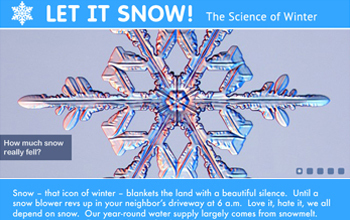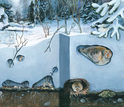Hola amigos: A VUELO DE UN QUINDE EL BLOG., Nieve - ese icono de invierno - mantas de la tierra con un hermoso silencio. El amor o el odio, todos dependemos de nieve. Nuestro suministro de agua durante todo el año viene en gran parte de la nieve derretida.
Pero no somos los únicos que necesitan nieve.
Especies de hongos microscópicos y 800 libras-alces requieren como mucho, si no más. Sobreviven el invierno viviendo en iglú de la naturaleza: la nieve.
Y profusión de primavera de flores? Están fertilizados por nutrientes en la nieve.
Si usted está planeando para patinar en un lago congelado o río este invierno, a pie en una pendiente de nieve, o, cuando llega la primavera, dependerá de deshielo para llenar su depósito, puede que tenga que pensar dos veces.
Pero no somos los únicos que necesitan nieve.
Especies de hongos microscópicos y 800 libras-alces requieren como mucho, si no más. Sobreviven el invierno viviendo en iglú de la naturaleza: la nieve.
Y profusión de primavera de flores? Están fertilizados por nutrientes en la nieve.
Si usted está planeando para patinar en un lago congelado o río este invierno, a pie en una pendiente de nieve, o, cuando llega la primavera, dependerá de deshielo para llenar su depósito, puede que tenga que pensar dos veces.
El invierno está cambiando, cada vez menos como las estaciones frías podemos recordar. El "nuevo invierno" tiene consecuencias mucho más allá de diciembre a marzo. Afecta la primavera y el verano, también, incluyendo fechas de floración de plantas '- y especies como los colibríes que dependen de los tiempos de floración de precisión para el néctar.
More information...
Report reveals inner worlds of snow and winter, and their importance to humans and ecosystems
 Credit and Larger Version |
Snow -- that icon of winter -- blankets the land with a beautiful silence. Love it or hate it, we all depend on snow. Our year-round water supply largely comes from snowmelt.
But we're not the only ones who need snow.
Species from microscopic fungi to 800-pound-moose require it as much, if not more. They survive the winter by living in nature's igloo: snow.
And spring's profusion of flowers? They're fertilized by nutrients in snow.
If you're planning to skate on a frozen lake or river this winter, ski on a snowy slope, or, when spring arrives, depend on snowmelt to fill your reservoir, you may need to think twice.
In celebration of snow and winter as we know it, and in a look at what winter may be like in the future, the National Science Foundation (NSF) has launched a new special report: Let It Snow! The Science of Winter.
The report focuses on projects supported largely by NSF's Directorate for Geosciences and Directorate for Biological Sciences/Division of Environmental Biology.
Grants from these areas fund research on subjects as diverse as measuring snowfall; tracking snowstorm "bombs," as whiteouts are known in meteorology; studying animals and plants that live beneath the snow in an ecosystem called the subnivian; searching for snowmelt, or "white gold"; and the bane of winter -- dust from the atmosphere that causes snow to melt before its time.
Go winter storm-chasing, enter nature's igloo
In the report, explore such topics as winter storm-chasing, a conifer tree's view of snow, life in nature's igloo, and where our winters have gone.
Watch a video of snowflakes photographed by a new high-speed camera, and another on the water that's locked in snow and ice: a zero sum game.
As you look out your window at a snow-covered landscape, or perhaps one that has been so in the past -- and even if you live below the snowline -- find out what scientists are learning about winter.
It matters, even if you never see a snowflake.
-NSF-
Media Contacts Cheryl Dybas, NSF, (703) 292-7734, cdybas@nsf.gov
The National Science Foundation (NSF) is an independent federal agency that supports fundamental research and education across all fields of science and engineering. In fiscal year (FY) 2016, its budget is $7.5 billion. NSF funds reach all 50 states through grants to nearly 2,000 colleges, universities and other institutions. Each year, NSF receives more than 48,000 competitive proposals for funding and makes about 12,000 new funding awards. NSF also awards about $626 million in professional and service contracts yearly.
Useful NSF Web Sites:
NSF Home Page:
http://www.nsf.gov
NSF News:
http://www.nsf.gov/news/
For the News Media:
http://www.nsf.gov/news/newsroom.jsp
Science and Engineering Statistics:
http://www.nsf.gov/statistics/
Awards Searches:
http://www.nsf.gov/awardsearch/

Can autumn snowfall in Siberia predict winter in the U.S. and Europe? Yes, say researchers.
Credit and Larger Version

Scientists at NSF's Critical Zone Observatories study snowmelt and water resources.
Credit and Larger Version

A secret world, unseen by most humans, is alive beneath the surface of winter's snow.
Credit and Larger Version

The willow ptarmigan is one of many species that use snow as an insulating blanket.
Credit and Larger Version

How do wood frogs survive being frozen in winter? By living under the snow surface.
Credit and Larger Version
The National Science Foundation (NSF)
Guillermo Gonzalo Sánchez Achutegui
ayabaca@gmail.com
ayabaca@hotmail.com
ayabaca@yahoo.com
Inscríbete en el Foro del blog y participa : A Vuelo De Un Quinde - El Foro!

No hay comentarios:
Publicar un comentario